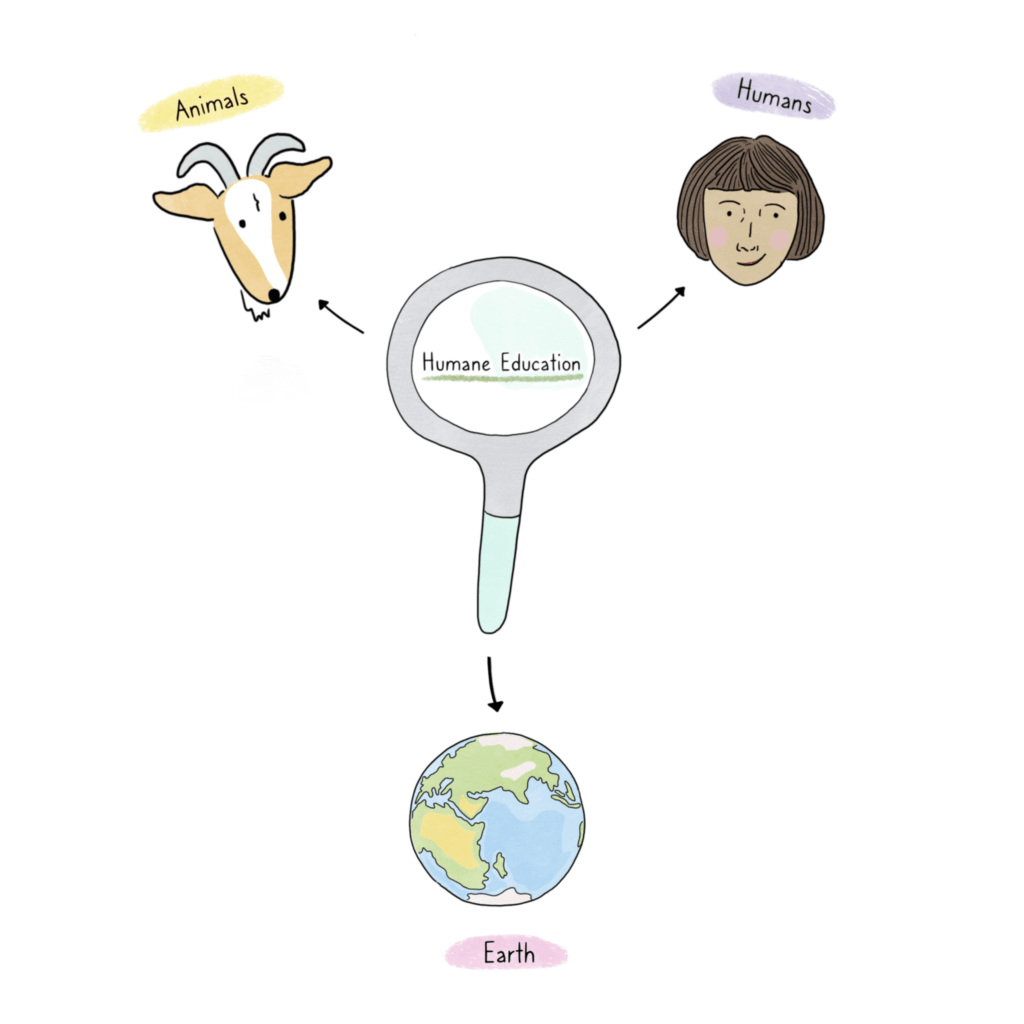
Introduction
As a global community, we are standing at a crossroads right now. Scientific evidence tells us we are close to the tipping point of climate change, humanitarian calamity, and animal crises. The convergence of social planetary issues means positive transformation of any kind isn’t going to be effective without the consideration of nonhuman life. Ironically, the Covid-19 pandemic has strengthened many people’s connection to nonhuman life, as daily life and learning are no longer as confined as they once were to enclosed spaces like schools and office buildings. People have had so many more opportunities to learn about and appreciate the nonhuman world.
Given the current climate of social planetary reform, there has never been a better time for animal sanctuaries to adopt a humane lens in their educational programming. Humane education provides remedies to social planetary issues like animal exploitationExploitation is characterized by the abuse of a position of physical, psychological, emotional, social, or economic vulnerability to obtain agreement from someone (e.g., humans and nonhuman animals) or something (e.g, land and water) that is unable to reasonably refuse an offer or demand. It is also characterized by excessive self gain at the expense of something or someone else’s labor, well-being, and/or existence. and leaves learners inspired to do what they can to help dismantle these problems. So, let’s take a dive into humane education: what is it and how can it be helpful in a sanctuary setting?
What Is Humane Education?
Humane education is a long-standing field of education that began in the 1800s. Although it has evolved significantly over the last century, humane education has always advocated for the ethical treatment of animals and humans. It gained widespread popularity in the late 1800s and early 1900s, but started to dissipate shortly after the world wars, primarily because there was little scientific evidence demonstrating that it was effective. This was not due to any evidence indicating it was not effective, but simply because very little empirical research was conducted to support that it was effective. Nonetheless, humane education remains widely practiced by various organizations throughout the world, including many animal advocacy groups. Today, the Academy of Prosocial Learning defines humane education as a pedagogy that “encourages cognitive, affective, and behavioral growth through personal development of critical thinking, problem solving, perspective taking, and empathy as it relates to people, animals, the planet, and the intersections among them. Education taught through the lens of humane pedagogy supports more than knowledge acquisition; it allows learners to process personal values and choose prosocial behaviors aligned with those values”.
Humane Education in A Sanctuary Setting

Animal sanctuaries offer people a unique opportunity to learn about and engage with the world in a more ecocentricAn ecocentric view holds that Earth’s ecology and ecosystems (including its atmosphere, water, land, and all life forms) have intrinsic value and should be protected and valued even if they can’t be used by humans as resources. environment, helping learners actively consider the perspectives of nonhuman animals. Whether via in-person or virtual education programs, sanctuaries can connect their communities to animals in a way other learning environments cannot. As a theory and practice of teaching that is committed to the politics of liberation and representation of the intrinsic value of all beings, humane education can help sanctuaries facilitate this connection more effectively with the integration of the pedagogy’s core components into their educational programming.
According to the Institute for Humane Education, humane education encompasses four main elements, all of which can comfortably be integrated into a sanctuary setting:
Element One: Providing accurate information about the issues of our time so people have the information they need to discern fact from opinion and understand the consequences of their decisions as citizens
As animal advocates, it’s important to provide people with accurate species-specific knowledge. There are countless false harmful cultural narratives regarding animals that are based in anthropocentrismAnthropocentrism is the belief that human beings are the most important entity in the world. Anthropocentrism interprets or regards the world in terms of human values and experiences. and misinformation. One important way sanctuaries can counter these narratives is by sharing factual information that helps visitors understand how and why an animal behaves in a specific way, what their needs are both individually and collectively, and how our daily choices impact their lives in both positive and negative ways. Accurate life-affirming language should be at the basis of this practice. Helping others undo how they learned to speak about animals is part of how we can undo harmful narratives.
Element Two: Fostering curiosity, creativity, and critical-, strategic-, and systems- thinking so people can evaluate information and solve problems collaboratively
Animal sanctuaries are ideal spaces to offer folks a comprehensive worldview in which all beings are considered. Sanctuaries can share their critical thinking skills with their audiences and help them contribute to a collective and personal process of liberation from the catastrophic concepts of speciesismA form of discrimination based on species membership; the belief that different species of animals deserve different ethical considerations regardless of whether they have similar needs or interests. and anthropocentrism. However, in order to dismantle speciesism and anthropocentrism, it’s important to educate visitors through a holistic lens that is critical of not only animal exploitation, but also the oppressive systems that enable and reinforce it. Sanctuaries can help their audiences recognize that animal exploitation serves to undermine all of us – humans, animals, and the planet – by drawing the connections between animal exploitation and other oppressive forces like environmental degradation, ableism, patriarchy, capitalism, colonialism, white supremacy and more*.
*Wait – how are these things connected to animals?
When talking about animal exploitation and other systems of oppression, it may be challenging to see that these issues are connected to one another. However, a close look at how any oppressive system works can help clarify the connection. An oppressive system is “one that functions to explain, maintain, and justify institutions, relationships and practices of unjustified domination and subordination” (Karen Warren, Feminist Environmental Philosophy). For example, an oppressive system that is speciesist functions to justify the domination and subordination of nonhuman animals by humans. All systems of oppression are woven together in an overarching structure of hierarchy and domination. This means a commitment to dismantling oppressive systems like animal exploitation requires the dismantling of all other oppressive systems. Interested in exploring these ideas further? Check out the works of the Combahee River Collective, Kimberlé Crenshaw, Patricia Hill Collins, Karen Warren, and Aph Ko!
Element Three: Instilling compassion, empathy, respect, and responsibility so people have the motivation to face challenges and act with integrity
Sanctuary spaces can disrupt speciesism when they offer visitors the opportunity to learn about animals as actors and communities with their own needs, desires, and lived realities. This enables people to draw connections and comparisons between themselves and the animals they meet and nurture empathic attitudes and behaviors. The goal isn’t to convince them that animals are just like humans, rather that they are not in opposition to us. They are simply their own unique phenomenon deserving of kindness and respect.
Element Four: Offering positive choices that benefit oneself, other people, animals, and Earth
Humane education allows learners to draw connections between all kinds of social planetary movements in a way that inspires creative solutions to some of the globe’s biggest problems, like animal exploitation. One of the ways sanctuaries can inspire creative solutions is by empowering their visitors to become engaged members of their own communities. A humane lens encourages them to ask questions such as: What are the needs of my community right now? What are nonhumans facing in my community? What are humans facing in my community? What are the intersections among them? Issues like pollution, poverty, climate change, animal exploitation, violence, inequality, and hunger make the humane lens a necessity for everyone. By exploring the intersections among these issues in their own communities, sanctuaries can provide safe opportunities for their audiences to take action as confident, informed citizens who make choices that align with their values and make a positive impact on everyone.
Conclusion
At The Open Sanctuary Project, our mission is to provide responsibly researched and crafted resources with the intention of promoting compassionate animal sanctuary practices. One of the ways in which we are working towards that goal is by developing resources like this that support sanctuaries who want to cultivate a culture of learning and empathy. Sanctuary education programs can provide critical-thinking and empathy-building learning opportunities that help people understand the perspectives of nonhuman animals. In learning to integrate humane education into these learning experiences, sanctuaries can develop as educator-activist spaces that identify local and global social planetary issues and inspire positive social transformation on behalf of animals as well as humans and the planet. If you are interested in learning more about humane education and how it can inspire your sanctuary’s educational programming, check out the Humane Education Coalition’s Resource Toolkit. You’ll find books, events, films, funding information, lesson plans, research, and more!
Sources
Resource Toolkit | Humane Education Coalition
Institute for Humane Education








